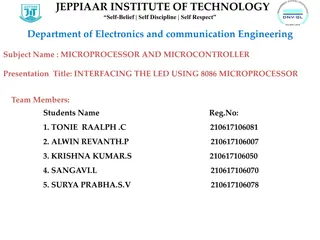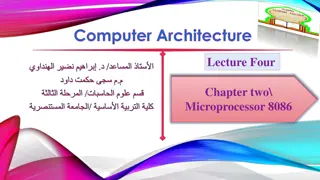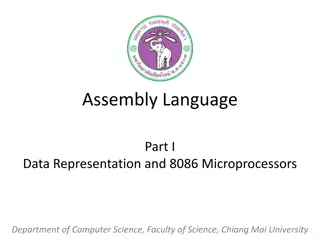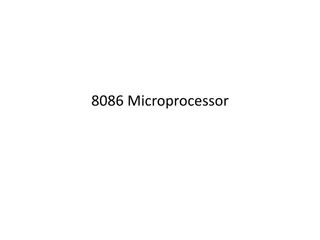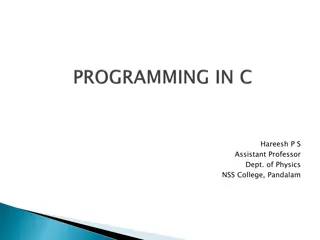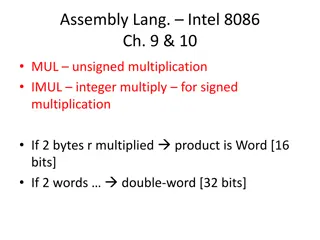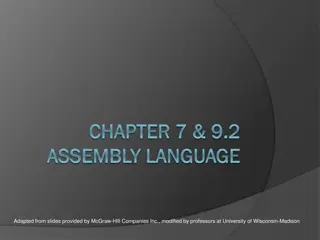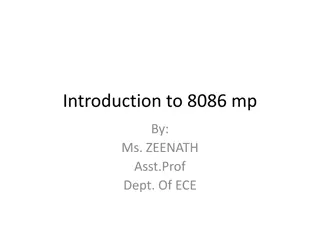Introduction to 8086 Assembly Language Programming
Assembler directives play a crucial role in guiding the assembly process for 8086 assembly language programming. They dictate how operands are handled, memory organization, and more. This content covers essential directives such as ASSUME, DB, DW, DD, DQ, and DT, providing syntax examples and explanations for each directive.
Download Presentation

Please find below an Image/Link to download the presentation.
The content on the website is provided AS IS for your information and personal use only. It may not be sold, licensed, or shared on other websites without obtaining consent from the author.If you encounter any issues during the download, it is possible that the publisher has removed the file from their server.
You are allowed to download the files provided on this website for personal or commercial use, subject to the condition that they are used lawfully. All files are the property of their respective owners.
The content on the website is provided AS IS for your information and personal use only. It may not be sold, licensed, or shared on other websites without obtaining consent from the author.
E N D
Presentation Transcript
UNIT-II 8086 ASSEMBLY LANGUAGE PROGRAMMING BY: Ms. ZEENATH DEPT. Of ECE
Contents at a glance: 8086 Instruction Set Assembler directives Procedures and macros. 8086 MEMORY INTERFACING: 8086 addressing and address decoding Interfacing RAM, ROM, EPROM to 8086
ASSEMBLER DIRECTIVES Assembler directives are the commands to the assembler that direct the assembly process. They indicate how an operand is treated by the assembler and how assembler handles the program. They also direct the assembler how program and data should arrange in the memory. ALP s are composed of two type of statements. The instructions which are translated to machine codes by assembler. The directives that direct the assembler during assembly process, for which no machine code is generated.
1. ASSUME: Assume logical segment name Syntax: ASSUMEsegreg:segname, segreg:segname Ex: ASSUME CS:CODE ASSUME CS:CODE,DS:DATA,SS:STACK
2.DB: Define Byte The DB directive is used to reserve byte or bytes of memory locations in the available memory. Syntax: Name of variable DB initialization value. Ex: MARKS DB 35H,30H,35H,40H NAME DB VARDHAMAN
3.DW: Define Word The DW directive serves the same purposes as the DB directive, but it now makes the assembler reserve the number of memory words(16-bit) instead of bytes. Syntax: variable name DW initialization values. Ex: WORDS DW 1234H,4567H,2367H WDATA DW 5 Dup(522h) (or) Dup(?)
4. DD: Define Double: The directive DD is used to define a double word (4bytes) variable. Syntax: variable name DD 12345678H Ex: Data1 DD 12345678H
5. DQ: Define Quad Word This directive is used to direct the assembler to reserve 4 words (8 bytes) of memory for the specified variable and may initialize it with the specified values. Syntax: Name of variable DQ initialize values. Ex: Data1 DQ 123456789ABCDEF2H
6.DT: Define Ten Bytes The DT directive directs the assembler to define the specified variable requiring 10 bytes for its storage and initialize the 10-bytes with the specified values. Syntax: Name of variable DT initialize values. Ex: Data1 DT 123456789ABCDEF34567H
7. END: End of Program The END directive marks the end of an ALP. The statement after the directive END will be ignored by the assembler.
8. ENDP: End of Procedure The ENDP directive is used to indicate the end of procedure. In the AL programming the subroutines are called procedures. Ex: Procedure Start : Start ENDP
9. ENDS: End of segment The ENDS directive is used to indicate the end of segment. Ex: DATA SEGMENT : DATA ENDS
10. EVEN: Align on Even memory address The EVEN directives updates the location counter to the next even address. Ex: EVEN Procedure Start : Start ENDP The above structure shows a procedure START that is to be aligned at an even address.
11. EQU: Equate The directive EQU is used to assign a label with a value or symbol. Ex: LABEL EQU 0500H ADDITION EQU ADD
12. EXTRN: External and public The directive EXTRN informs the assembler that the names, procedures and labels declared after this directive have been already defined in some other AL modules. While in other module, where names, procedures and labels actually appear, they must be declared public using the PUBLIC directive. Ex: MODULE1 SEGMENT PUBLIC FACT FAR MODULE1 ENDS MODULE2 SEGMENT EXTRN FACT FAR MODULE2 END
13. GROUP: Group the related segments This directive is used to form logical groups of segments with similar purpose or type. Ex: PROGRAM GROUP CODE, DATA, STACK*CODE, DATA and STACK segments lie within a 64KB memory segment that is named as PROGRAM.
14. LABEL: label The label is used to assign name to the current content of the location counter. Ex: CONTINUE LABEL FAR The label CONTINUE can be used for a FAR jump, if the program contains the above statement.
15. LENGTH: Byte length of a label This is used to refer to the length of a data array or a string Ex : MOV CX, LENGTH ARRAY
16. LOCAL: The labels, variables, constant or procedures are declared LOCAL in a module are to be used only by the particular module. Ex : LOCAL a, b, Data1, Array, Routine
17.NAME: logical name of a module The name directive is used to assign a name to an assembly language program module. The module may now be refer to by its declared name. Ex : Name addition
18. OFFSET: offset of a label When the assembler comes across the OFFSET operator along with a label, it first computing the 16-bit offset address of a particular label and replace the string OFFSET LABEL by the computed offset address. Ex : MOV SI, offset list
19. ORG: origin The ORG directive directs the assembler to start the memory allotment for the particular segment, block or code from the declared address in the ORG statement. Ex: ORG 1000H
20. PROC: Procedure The PROC directive marks the start of a named procedure in the statement. Ex: RESULT PROC NEAR ROUTINE PROC FAR
21. PTR: pointer The PTR operator is used to declare the type of a label, variable or memory operator. Ex : MOV AL, BYTE PTR [SI] MOV BX, WORD PTR [2000H]
22. SEG: segment of a label The SEG operator is used to decide the segment address of the label, variable or procedure. Ex : MOV AX, SEG ARRAY MOV DS, AX
23. SEGMENT: logical segment The segment directive marks the starting of a logical segment Ex: CODE SEGMENT: CODE ENDS 24.SHORT: The SHORT operator indicates to the assembler that only one byte is required to code the displacement for jump. Ex : JMP SHORT LABEL
25. TYPE: The TYPE operator directs the assembler to decide the data type of the specified label and replaces the TYPE label by the decided data type. For word variable, the data type is 2. For double word variable, the data type is 4. For byte variable, the data type is 1. Ex : STRING DW 2345H, 4567H MOV AX, TYPE STRING AX=0002H
26. GLOBAL: The labels, variables, constants or procedures declared GLOBAL may be used by other modules of the program. Ex : ROUTINE PROC GLOBAL. 27. FAR PTR: This directive indicates the assembler that the label following FAR PTR is not available within the same segment and the address of the label is of 32-bits i.e 2-bytes of offset followed by 2-bytes of segment address. Ex : JMP FAR PTR LABEL
28. NEAR PTR: This directive indicates that the label following NEAR PTR is in the same segment and needs only 16-bit i.e 2-byte offset to address it Ex : JMP NEAR PTR LABEL CALL NEAR PTR ROUTINE





